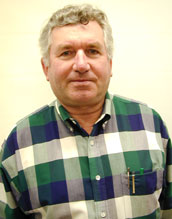Thursday morning I got to tour the Meat lab before I started working. At this point in the year the lab is usually void of animals because everything is being cleaned, and this year, as a result of the grant, renovations are going on. All the equipment is still there, however, and it was interesting to see (in a dark sort of way). I saw the holding pens where animals were kept before they were slaughtered, and the killing floor where it all took place. There were two different pens (one for cows and the other for pigs, sheep and goats) where the animals were shot (cows) or shocked (pigs, sheep, goats) and then their blood was drained. After seeing all of that, I'm really glad that I'll never need to take a meat science class, because I don't think I could handle watching an actual slaughter. It was, however, interesting to hear about the various rules that were in place to ensure a humane slaughter. For example, if any animal were to fall on its way to be slaughtered, its meat could not be sold. In fact, the meat lab had recently invested $20,000 in a slip-proof floor after an incident a couple years ago. I also found out that although the holding room had a steel fence that was about eight feet high, some of the cattle had occasionally been known to jump up and get the front half of their body stuck on the fence. While I was there, Dr. Gregg Rentfrow talked about the kind of research they did, and it seems like it's mostly just changing what an animal eats and then determining how that affected the quality and flavor of the animal. So basically, whenever they slaughtered a pig, the people who worked in the meat lab got to take free bacon. He also told me that people worried more than they needed to about antibiotics in their meat because in order to be sold for general consumption, the cow was tested for signs of an infection before slaughter, and was tested for antibiotics afterward.
This morning I went on a tour of the UK hospital before I went into the lab. In an earlier post I mentioned possibly shadowing a doctor during the eight weeks I'm spending here, but I don't think that's going to happen since the hours I work are kind of irregular, and I want to be able to fully commit to what I'm doing.
I know I don't need to make all of my career decisions right now, but there are two options I'm really considering. The first, and the reason I'm here right now, is going into research. I love learning and being a student, and I think researching something I'm interested in would really facilitate that (it's like being a professional student without the loans!). If I do end up going that direction, I think experiences like this will help me figure out exactly what I want to study, and it also gives me a chance to see what kind of lifestyle research would entail. So far, I'm totally sold on the lifestyle aspect. When I was working with Jen she would arrange her schedule so that she would be able to see at least one of the World Cup games every day, and Dr. Newman actually owns cadaver dogs and volunteers with search and rescue. Actually, this week or next she's going up to Dayton, OH to respond to a simulated disaster, which is kind of incredible. The other career path I've been considering is osteopathic medicine, with an emphasis on public health. I used to think that medicine would require far more people skills than research, but now I'm starting to change my mind. In medicine I would be interacting with all different kinds of patients and other doctors and nurses, but I'm starting to understand that things aren't really all that different in research. All the departments need to work together to share their findings and their equipment, and most projects involve the cooperation of a lot of very qualified people with a lot of diverse interests. It's way more social than I ever expected, and I think the more important difference between the two is the lifestyle.




